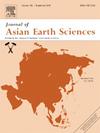Petrogenesis and tectonic implications of blueschist-facies garnet-mica schist in the Dabie orogenic belt, central China
IF 2.7
3区 地球科学
Q2 GEOSCIENCES, MULTIDISCIPLINARY
引用次数: 0
Abstract
The Dabie orogenic belt (DOB) in central China is renowned for studies of ultrahigh-pressure metamorphism due to deep continental subduction. However, relatively high-pressure and low-temperature (HP/LT) metamorphism in the DOB is poorly understood. To provide constraints on such metamorphism, we carried out a detailed petrological investigation on a garnet-mica schist from the Central Dabie metamorphic zone. Thermodynamic calculation, based on petrographic and mineral chemical data, revealed three distinct metamorphic episodes (i.e., M1, M2, and M3) with pressures and temperatures of 1.98 ± 0.01 GPa/457 ± 3°C, 1.93 ± 0.06 GPa/515 ± 19°C, and 1.51 ± 0.19 GPa/525 ± 14°C, respectively, which are generally under the HP/LT conditions of blueschist-facies metamorphism. The resulting clockwise P–T path reflects isobaric heating (M1 → M2) and isothermal decompression (M2 → M3), suggesting termination of the slab subduction and subsequent rapid uplift, respectively. Furthermore, zircon analysis yielded two distinct groups. Zrn-I represents the core of the zircons and exhibits an inherited magmatic origin, with a Neoproterozoic age range of 827–682 Ma; Zrn-II corresponds to the rim of the zircons and has a metamorphic origin, with an age of 197 ± 5 Ma, correlating with the M3 episode. These results, combined with previous studies, suggest that the transition from shallow warm subduction to deep cold subduction in the DOB may occur at a depths of 35–65 km in a low geothermal gradient environment, and the final exhumation of the orogenic belt to the surface may originate from the large-scale extension and deformation in eastern China.

求助全文
约1分钟内获得全文
求助全文
来源期刊

Journal of Asian Earth Sciences
地学-地球科学综合
CiteScore
5.90
自引率
10.00%
发文量
324
审稿时长
71 days
期刊介绍:
Journal of Asian Earth Sciences has an open access mirror journal Journal of Asian Earth Sciences: X, sharing the same aims and scope, editorial team, submission system and rigorous peer review.
The Journal of Asian Earth Sciences is an international interdisciplinary journal devoted to all aspects of research related to the solid Earth Sciences of Asia. The Journal publishes high quality, peer-reviewed scientific papers on the regional geology, tectonics, geochemistry and geophysics of Asia. It will be devoted primarily to research papers but short communications relating to new developments of broad interest, reviews and book reviews will also be included. Papers must have international appeal and should present work of more than local significance.
The scope includes deep processes of the Asian continent and its adjacent oceans; seismology and earthquakes; orogeny, magmatism, metamorphism and volcanism; growth, deformation and destruction of the Asian crust; crust-mantle interaction; evolution of life (early life, biostratigraphy, biogeography and mass-extinction); fluids, fluxes and reservoirs of mineral and energy resources; surface processes (weathering, erosion, transport and deposition of sediments) and resulting geomorphology; and the response of the Earth to global climate change as viewed within the Asian continent and surrounding oceans.
 求助内容:
求助内容: 应助结果提醒方式:
应助结果提醒方式:


